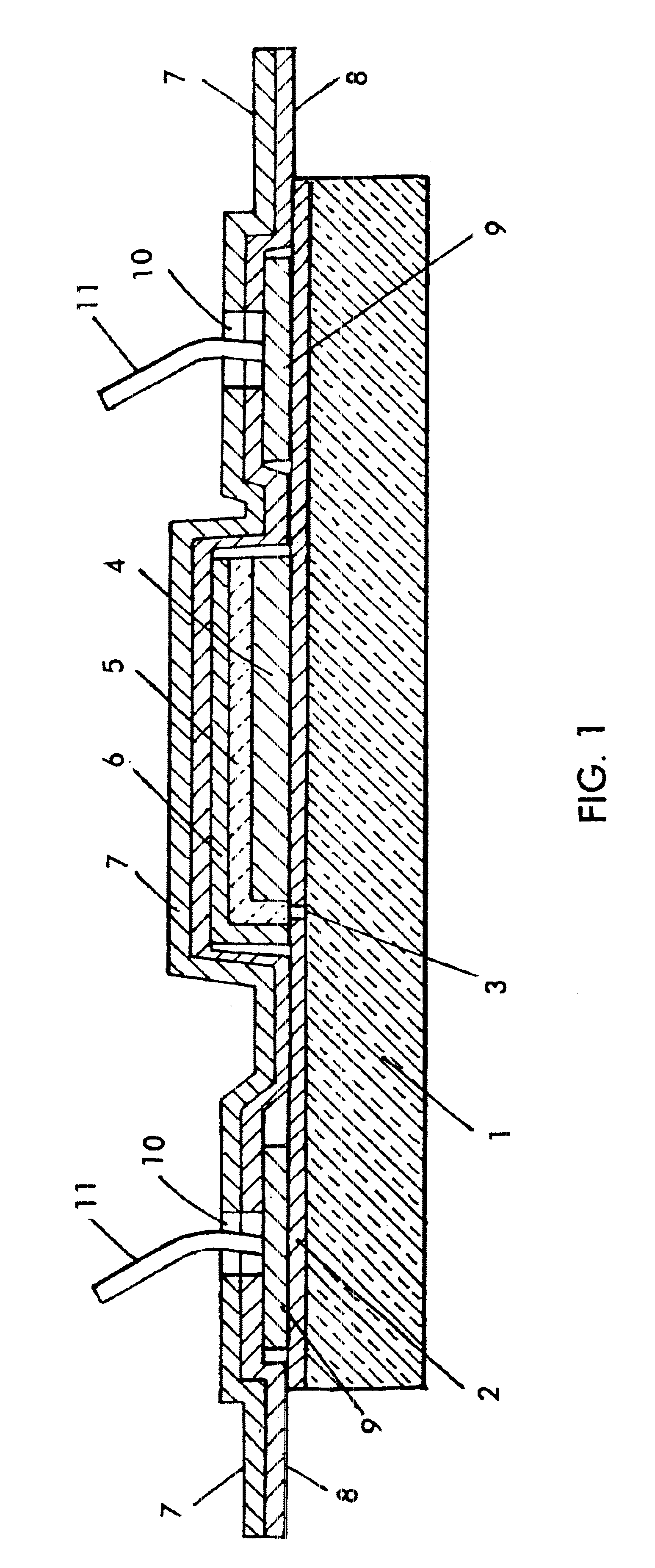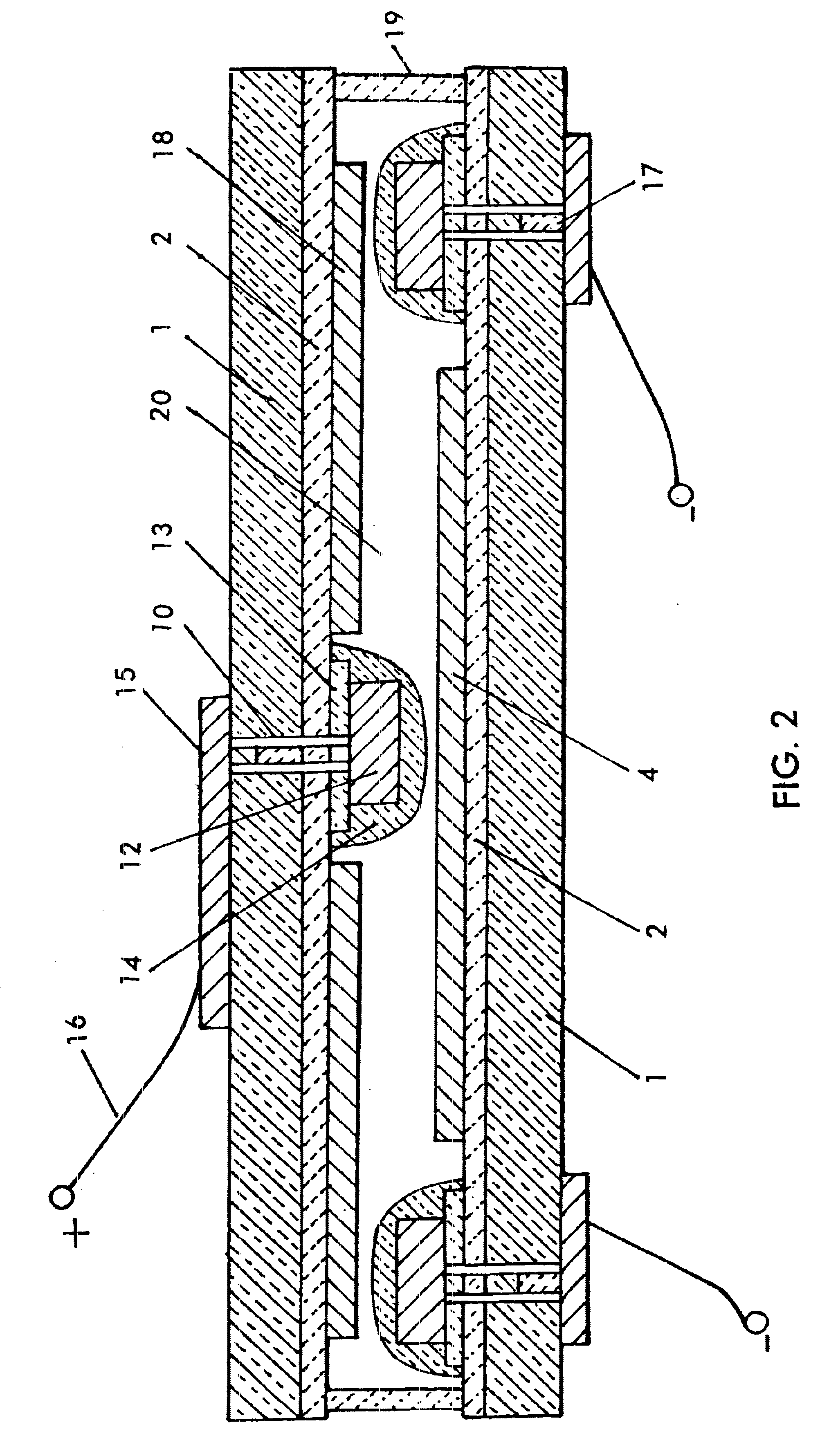Method to implement sealing and electrical connections to single cell and multi-cell regenerative photoelectrochemical devices
a photoelectrochemical device and electrical connection technology, applied in the field of rpec cells, can solve the problems of affecting the efficiency of the rpec device, high resistive loss, and difficulty in maintaining the hermetic sealing of said cells, and achieves the effect of reducing surface roughness and/or porosity, and increasing cell resistan
- Summary
- Abstract
- Description
- Claims
- Application Information
AI Technical Summary
Problems solved by technology
Method used
Image
Examples
example 1
(see FIG. 1)
Standard window glass with a doped tin oxide TEC film is selectively isolated using a CO.sub.2 laser. A titania paste is then screen printed and fired in a belt furnace. A ceramic oxide spacer layer is also screen printed over the titania and fired in a belt furnace. A carbon based catylist layer is then screen printed as to overlap the TEC glass isolation and the three layers are then fired once more in a belt furnace. The module is then placed in an alcohol solution of cis-[bis thiacyanato bis[4,4-dicarboxy-2-2-bipyridine Ru(II)] sensitiser at room temperature for several hours and then rinsed and dried with nitrogen. An electrolyte containing an iodide / triiodide redox couple is then placed dropwise onto the dyed layers and allowed to soak in as pads of thin copper foil (3 mm.times.3 mm) are conductively bonded to the TEC glass using a conductive paste. A laminate material consisting of an Aluminium backing and surlyn polymer is preformed with holes to be positioned ov...
example 2
(see FIG. 2)
With reference to FIG. 2, The RPEC cell comprises two glass substrates (1), both of which are coated with TEC layer (doped tin oxide) (2) which is isolated using a pulsed YAG laser. Patterned conductive silver material (7) is screen printed and fired. A protective layer (6) of indium tin oxide is deposited between conductive material and TEC layer prior to screen printing. A polymeric sealant layer (8) is deposited over the conductive material. Holes (9) through the substrates and coatings are made by laser drilling from the non-coated glass surface. The internal surface of the holes in the glass and coatings and a small area on the non-coated surface of the glass has been coated by a separate application of silver paste (10) that is bonded to substrate (1) and is electrically connected to pattern of conductive material (7). Standard copper wires (11) are bonded to the substrates (1) and electrically connected to the silver layer (10). The holes are sealed with silicone ...
example 3
As shown in FIG. 3
Example 4
The following example is illustrative only, and other deposition methods, uses, adaptations and features of the invention will be apparent to those of ordinary skill in the art.
Manufacture of Protective Oxide Layer.
Diethanolamine in the amount of 323 g is placed with mixing into the first container of 2917 g of dry isopropanol. Titanium alkoxide in the form of Ti(OC.sub.3 H.sub.7).sub.4, in the amount of 873 g is placed with mixing into the first container. Water in the amount of 111 g is placed with mixing into the second container of 868 g of isopropanol. The water / isopropanol solution in the second container is slowly placed with mixing into the first container. The final solution is applied to the substrate with a controlled thickness by dip coating. Upon withdrawal of the substrate into a controlled humidity atmosphere in which the humidity is maximised without allowing condensation, evaporation and hydrolysis simultaneously occur, leaving a residue. ...
PUM
| Property | Measurement | Unit |
|---|---|---|
| transparent | aaaaa | aaaaa |
| band gap | aaaaa | aaaaa |
| electrically conductive | aaaaa | aaaaa |
Abstract
Description
Claims
Application Information
 Login to View More
Login to View More - R&D
- Intellectual Property
- Life Sciences
- Materials
- Tech Scout
- Unparalleled Data Quality
- Higher Quality Content
- 60% Fewer Hallucinations
Browse by: Latest US Patents, China's latest patents, Technical Efficacy Thesaurus, Application Domain, Technology Topic, Popular Technical Reports.
© 2025 PatSnap. All rights reserved.Legal|Privacy policy|Modern Slavery Act Transparency Statement|Sitemap|About US| Contact US: help@patsnap.com



